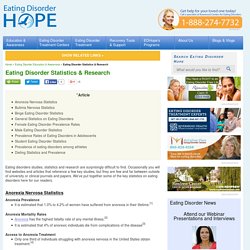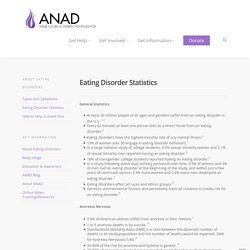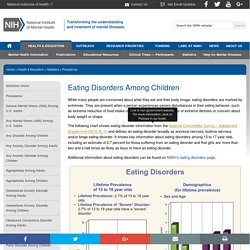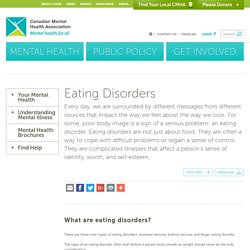

Statistics. National Eating Disorder Information Centre (NEDIC) Understanding Statistics on Eating Disorders It is important to make sure that you understand the meaning of any eating disorder statistic you may read, and how it can be used.

Look at the research from which the statistics come: What kind of questions did the researchers ask? How was information gathered? Who did they ask? The statistics NEDIC uses are gathered from peer-reviewed articles in highly regarded journals. Statistics are also useful in initiating discussion on eating disorders, and in encouraging people to help work toward the healing, health and well-being of everyone affected by an eating problem. Please note: The following statistics have been compiled from specific research studies and papers as cited. Statistics on Eating Disorders: Anorexia, Bulimia, Binge Eating. Eating disorders studies, statistics and research are surprisingly difficult to find.

Occasionally you will find websites and articles that reference a few key studies, but they are few and far between outside of university or clinical journals and papers. National Association of Anorexia Nervosa and Associated Disorders. General statistics: At least 30 million people of all ages and genders suffer from an eating disorder in the U.S.

Every 62 minutes at least one person dies as a direct result from an eating disorder.Eating disorders have the highest morality rate of any mental illness.13% of women over 50 engage in eating disorder behaviors.In a large national study of college students, 3.5% sexual minority women and 2.1% of sexual minority men reported having an eating disorder.16% of transgender college students reported having an eating disorder.In a study following active duty military personnel over time, 5.5% of women and 4% of men had an eating disorder at the beginning of the study, and within just a few years of continued service, 3.3% more women and 2.6% more men developed an eating disorder.Eating disorders affect all races and ethnic groups.Genetics, environmental factors, and personality traits all combine to create risk for an eating disorder.
Anorexia Nervosa: Bulimia Nervosa: “Diabulimia:” NIMH » Eating Disorders Among Children. While many people are concerned about what they eat and their body image, eating disorders are marked by extremes.

They are present when a person experiences severe disturbances in their eating behavior, such as extreme reduction of food intake or extreme overeating, or feelings of extreme distress or concern about body weight or shape. The following chart shows eating disorder information from the National Comorbidity Survey – Adolescent Supplement (NCS-A) Link to non-government website. For more information, click on Policies in our footer. NIMH » Eating Disorders. Eating Disorders - Canadian Mental Health AssociationCanadian Mental Health Association. There are three main types of eating disorders: anorexia nervosa, bulimia nervosa, and binge-eating disorder.

The signs of an eating disorder often start before a person looks unwell, so weight should never be the only consideration. Anorexia nervosa A person who experiences anorexia nervosa may refuse to keep their weight at a normal weight for their body by restricting the amount of food they eat or exercising much more than usual. They may feel overweight regardless of their actual weight. They may think about their body weight often and use it to measure their self-worth. Restricting food can affect a person’s entire body. Bulimia nervosa Bulimia nervosa involves periods of uncontrollable binge-eating, followed by purging (eliminating food, such as by vomiting or using laxatives). Health problems caused by bulimia nervosa may include kidney problems, dehydration, and digestive problems. About An Eating Disorder: Symptoms, Signs, Causes & Articles For Treatment Help.
What is an Eating Disorder? Eating Disorders describe illnesses that are characterized by irregular eating habits and severe distress or concern about body weight or shape. Eating disturbances may include inadequate or excessive food intake which can ultimately damage an individual’s well-being. The most common forms of eating disorders include Anorexia Nervosa, Bulimia Nervosa, and Binge Eating Disorder and affect both females and males. Demi Lovato speaks about her eating disorder. As posted by I Choose People Eating disorders can develop during any stage in life but typically appear during the teen years or young adulthood. Eating disorders commonly coexist with other conditions, such as anxiety disorders, substance abuse, or depression.